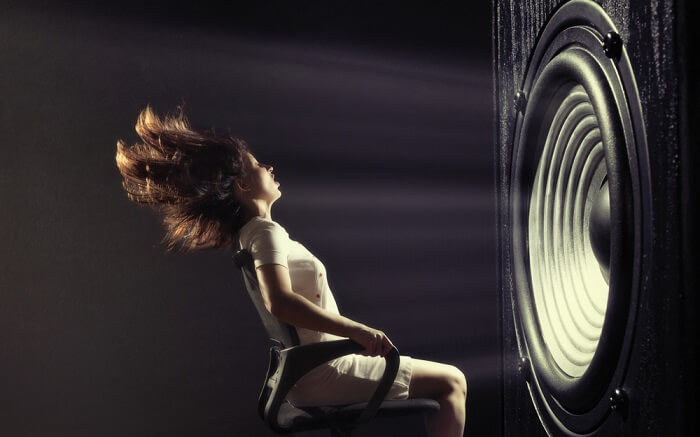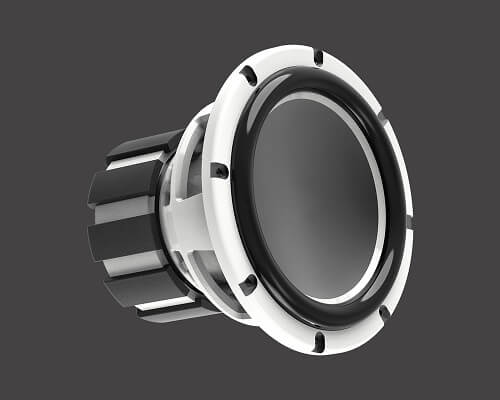The subwoofer is indispensable in a home theater installation to give the audience the feeling of being at the heart of the action. This is a speaker specialized in the reproduction of low frequencies (less than 200 Hz) such as those of the LFE channel (Low Frequency Effect – 10 Hz to 120 Hz) present on multichannel tracks 5.1, 7.1 etc.
The vast majority of subwoofers are active, and therefore have an integrated amplifier, although some manufacturers sometimes offer passive models requiring dedicated external amplification. The diameter of the speaker is decisive regarding the capacity of the subwoofer to reproduce the lowest frequencies.
Why use a Subwoofer?
The small speakers (less than 20 cm in diameter), whose diaphragm moves little, are adapted to reproduce the treble or midrange frequencies. But the reproduction of the bass and sub-bass frequencies requires a loudspeaker of large diameter, “loaded” in a large volume of air and equipped with a membrane whose suspension allows him important excursions. To produce bass, it is necessary to move a large volume of air, which compact speakers or satellite speakers are unable to do so whenever buying any sound gadget keep in mind quality of product and shop by price, color, locally and more.
The subwoofer is therefore essential in addition to a compact home theater speaker pack to reproduce the lowest octaves. It is also a valuable asset in supporting a pair of column loudspeakers or a big-screen home-theater speaker package with front column speakers, to explore with more authority and scale the bass frequencies, in hi-fi listening as in the context of a home-cinema session.
Where to place the subwoofer ?
Some manufacturers recommend placing the subwoofer between the two front left and right speakers, other prefer placement in a corner of the room. The best solution being the one that sounds best, your ears will be the only ones. Different tests may be necessary before finding the ideal location. It is generally considered that the location of the subwoofer is less critical than that of the speakers, although it is generally advisable to position it at the front of the listening area. In addition, most home theater amplifiers incorporate an automatic speaker calibration system that also manages the subwoofer and allows you to optimize the sound reproduction according to the acoustics of the room.
Factors Consideration Before Choosing a Quality Subwoofer ?
The diameter of the speaker
Generally, the larger the diameter of the loudspeaker, the more the subwoofer is able to reproduce very low frequencies. But when properly designed and implemented, some modest-diameter speakers deliver excellent results. The subwoofers intended for domestic use usually carry a bass speaker measuring between 16 and 30 cm in diameter. The subwoofers designed for professional audio systems and audiophiles systems or high-end home theater can board a speaker 38 to 46 cm in diameter. In any case, it is wise to choose a subwoofer with a loudspeaker larger than that of the main speakers, or at least equivalent.
The frequency response
The frequency response is a defining feature in the choice of a subwoofer. This is generally between 16 Hz and 30 Hz for the lowest frequency reproduced and 150 Hz for the highest frequency.
The low frequency therefore indicates how far the subwoofer can go down in the bass, or even the sub-bass, the one that “takes the guts” and makes physically feel the explosions and the shots in the movies. It is often on this characteristic that we tend to stop, but the high cutoff frequency is also important to take into account, since it must be ensured that it covers the lowest frequency reproduced by the associated speakers, especially if they are satellite speakers. In this case, it is necessary to choose a subwoofer capable of accurately reproducing the frequencies up to 150 Hz, to ensure a homogeneous connection.
The construction of the box
The subwoofers are subject to particular physical constraints that require a specific design. The box of the subwoofer must be extremely rigid. It is therefore often made of thick material and has internal reinforcements that increase the mass. The loudspeaker is a specific model, designed so that the very large deflection of the membrane does not cause audible distortion. This supposes a very well designed suspension and a very rigid membrane.
Integrated amplification
The vast majority of the subwoofers are equipped with their own integrated amplifier. There are many passive models but they require filtering and separate amplification. They are often reserved for integration (built-in subwoofers), professional use or very high-end configurations.
Generally, the greater the power of amplification built into the subwoofer, the better. But as high-power amps are more expensive, it’s a good idea to adapt the power of the subwoofer to that of the rest of the system, depending on its usage. If a subwoofer with a continuous power of 100 Watts can be enough hi-fi, it will often be too fair for home theater use, except in a room of modest size or for listening at low general volume. In home theater configuration, we consider that a subwoofer 150 Watts is a minimum to begin to truly enjoy the LFE channel of movies and TV series.
Sound pressure
Sound pressure level (SPL), expressed in decibel (dB), is because a subwoofer produces slow and wide sound waves, the lower frequencies are usually rather felt by the body of the listener that truly heard. In a stereo hi-fi system using two speakers, it is considered that a subwoofer capable of producing 110 dB (or more) over its useful bandwidth is generally sufficient.
But in home theater configuration, in addition to 5 or 7 speakers, the subwoofer should be able to produce ideally 120 dB of sound pressure.
The low frequencies are less well perceived by the ear than the medium and high frequencies. Thus, with a pack of five speakers each producing a sound level of 90 dB at 1 meter for 1 Watt injected by the home-theater amplifier, or 106 dB each for 40 Watts injected, the five speakers cumulative produce a sound level of about 118 dB. It is therefore essential to equip a powerful subwoofer, under penalty of getting a low level of low audible. Of course, if you listen at a confidential level, a modest subwoofer (SPL 105/110 dB) will do.
Connectivity
All subwoofers have at least a line level input called “low level” (RCA stereo) and / or an LFE input (mono RCA), to which is sometimes added a speaker level input also called “high level” ( speaker terminals), which can be accompanied by a speaker output.
The line input of the subwoofer is connected to the “SUB / LFE” output of the amp. This is the most common mode of connection of a subwoofer in home cinema (home theater amps, sound bars …), also adopted by some high-fidelity amps. Even if some subwoofers are equipped with a stereo input, the channels are mixed by the built-in amplifier module. It is therefore not necessary to connect these two inputs to the “SUB” output of an amplifier: only one is sufficient.
The high-level input (speakers) allows you to pick up the signal directly from the terminal block of the main speakers of the amplifier, and is indispensable with a hi-fi amplifier that does not have a pre-amplified output for the subwoofer. It is also highly recommended in hi-fi by some manufacturers of subwoofers.


